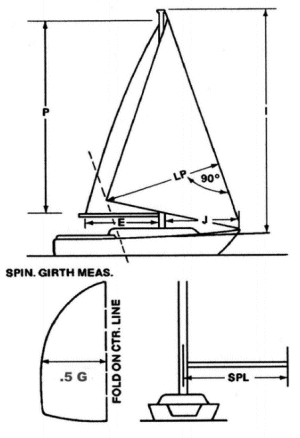General Kelt 760 Description
The Kelt 7.6 is a French design which was first built in France, and then under licence in Ontario, Canada. It won the very prestigious "boat of the year" award at the 1980 Paris Boat Show. The Kelt successfully squeezed a lot of living space, including an aft head and a real chart table, in seaworthy and modern looking 25 footer. Because these boats were built in the mid-1980s, the Kelt is one of the newer 25 footer that can be found on the Canadian used market. It should be noted that some Kelt 7.6s were built with a motor well for an outboard in lieu of a transom bracket.
Kelt 7.60 Specifications
LOA: 27'3" (8.3 m)
LWL: 21'0" (96.40 m)
Beam: 9'5" (2.88 m)
Displacement: 4500 lb (2041 kg)
Draft (swing keel): 2'5" - 5'3" (0.75 m - 1.60 m)
Draft (fixed keel): 4'3" (1.30 m)
Ballast (swing keel): 1950 lb (884.5 kg)
Ballast (fixed keel): 1765 lb (800.6 kg)
Sail Area: 285 sq-ft (26.2 sq-m)
Berths: 4-5
Max Speed: 6.4 knots
Headroom: 5'7"
Avg PHRF: 204
LWL: 21'0" (96.40 m)
Beam: 9'5" (2.88 m)
Displacement: 4500 lb (2041 kg)
Draft (swing keel): 2'5" - 5'3" (0.75 m - 1.60 m)
Draft (fixed keel): 4'3" (1.30 m)
Ballast (swing keel): 1950 lb (884.5 kg)
Ballast (fixed keel): 1765 lb (800.6 kg)
Sail Area: 285 sq-ft (26.2 sq-m)
Berths: 4-5
Max Speed: 6.4 knots
Headroom: 5'7"
Avg PHRF: 204
Mast-and-boom
The original mast-and-boom arrangement is a French production, made by Isomat. For replacement parts check this website: www.rigrite.com
Common Ratings for Kelt
NSYA rates the Kelt 7.6 with 135% Jib and O/B at PHRF 219 or Non-Spinnaker PHRF 237
Kelt 7.6 Rig Specs, Sail Area Calculations |
|
 The following formulas are approximate
The following formulas are approximate Sail areas depend on lots of factors, leach hollow, foot round, luff hollow etc. Also, remember that jib sail area in general is based on the forestay length, I. But all things considered, these numbers are close but should not be considered exact. They are rules of thumb, not measurements of a this specific boat. MainsailMainsail = (P x E) / 2 = 118 sq ftRacing Mainsail (add 10%) = 130 sq ft Genoa155% Genoa = (( J x I ) / 2) x 1.65 = 257 sq ft135% Genoa = (( J x I ) / 2) x 1.44 = 224 sq ft Jib
100% Jib = ( I x J ) / 2 = 156 sq ft SpinnakerSpinnaker Area = Max Luff x Max Girth x ( 70-85%) = 393 to 477 sq ft"Square" Spinnaker Area = Max Luff x Max Girth) = 561 sq ft Maximum Luff (.95 * sqrt (JSP^2 + ISP^2) = 30.55 feet Maximum Girth = 1.8 * JSP = 18.36 feet
|
||||||||||||||||||||||||||||||||||||||||||||||||||
|
Quantity Definitions
Basic quantities (inches converted to decimal) LOA : 24'11" (24.92) LWL: 21' Beam"9' 5" (9.42) Displacement: 4500 pounds Sail Area: 285 sq. feet (Main + 100% Fore triangle)Derived quantities
Displacement to LWL: 217 A medium value would be 200. 300 would be high (Heavy Cruising Boat) and 100 would be low (Ultra Light Displacement-ULDB). Boats with low numbers are probably uncomfortable and difficult to sail.Hull Speed: 6.14 This is the maximum speed of a displacement hull. Some racers and lighter boats are able to achieve greater speed by lifting over the bow wave and riding on top of the water,that is, planing.
Sail Area to Displacement: 16.73 The sail area is the total of the main sail and the area of the front triangle. I cannot be sure that this datum was entered correctly for each listed boat. A racing boat typically has large sail area and low displacement. A number less than 13 probably indicates that the boat is a motorsailer. High performance boats would be around 18 or higher.
LWL to Beam: 2.23 A medium value would be 2.7. 3.0 would be high and 2.3 would be low.
Motion Comfort:15.69 Range will be from 5 to 60+ with a Whitby 42 at the mid 30's. The higher the number the more comfort in a sea. This figure of merit was developed by the Yacht designer Ted Brewer and is meant to compare the motion comfort of boats of similar size and types.
Capsize Ratio: 2.28 A value less than 2 is considered to be relatively good; the boat should be relatively safe in bad conditions. The higher the number above 2 the more vulnerable the boat. Is just a rough figure of merit and controversial as to its use.
Sailing Category: cruiser/racer The four categories are racer, racer/cruiser, cruiser/racer, and cruiser in order of descending performance.
Pounds/Inch: 707 The weight required to sink the yacht one inch. If the boat is in fresh water multiply the result by 0.975. If you know the beam at the waterline (BWL) multipy the result by BWL/Beam.

